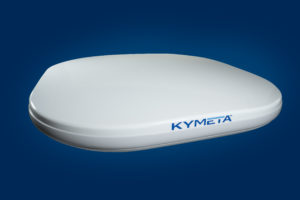Satellite equipment manufacturers are developing the smarter and more powerful antennas that customers want, but price is a barrier to adoption. While manufacturers debate when to scale production, manufacturers also wonder when the big order will arrive that delivers mass production efficiencies and lower prices.
“I’d like to believe that our antenna was smart for almost 10 years,” Walter Berger, president and co-chief executive at equipment marker Kymeta, said during a panel at the World Satellite Business Week in Paris recently.
Shey Sabripour, founder and chief executive of manufacturer CesiumAstro, agrees. “There’s a lot of software and algorithm code and within [field programmable gate arrays], and [application-specific integrated circuits] that live in these antennas,” he said during the session. The Austin, Texas-based startup has raised $88.2 million in funding, according to Crunchbase.
“You have to provide multiple beams. You have to be able to operate with multiple networks and satellite constellations. Therefore, you have to have a software-defined radio system that can house multiple waveforms [and] multiple modems,” Sabripour said. “But all of those technologies have matured, and we are maturing them and making them available to our customers.”
An antenna is more than just the metal that receives or emits radio frequency (RF) waves, he added. “It’s really more than an antenna. It’s an entire communication system. So the phased arrays that we work on are not just antennas … [but also] there’s an RF front end, there’s software-defined radio, there’s digital computing … On one end, bits come in and on the other end, photons come out.”
A smart antenna should be flexible enough to work for every customer, Alvaro Sanchez, chief executive of software maker Integrasys, said during the session. It should also work with every satellite operator “regardless of the constellation you are using, and whether your connectivity is multi-orbit.”
Supply chain challenges
When production volumes rise, prices fall. Kymeta’s first product cost more than $20,000, Kymeta’s Berger said. “Today, that pricing is in the mid-teens, and our expectation is that price will continue to come down.”
But supply chain issues are “hugely challenging now,” he added.
Volume orders could come from large, low-Earth orbit (LEO) constellations and government customers, said CesiumAstro’s Sabripour. An order to supply antennas for several hundred satellites could translate into an order for hundreds of thousands of chips, “which then allows us to negotiate [on price] with our chip suppliers.”
The startup took a risk and “just placed a large order for a number of chips, but you can only do that so much,” Sabripour said.
However, in order for the price to drop another order of magnitude, a larger market is needed, such as connected cars, he added, but they require a terminal that costs $50 or $100. “That’s not achievable with active phased-array technology, but it is achievable with some passive-array technologies such as Kymeta,” he said.
Although a $50 per terminal price is not in view, the industry could soon see a smart antenna costing several thousand dollars, Sabripour added.
“The future antenna will be even smarter and, counter-intuitively, even simpler to operate,” David Meltzer, Secretary General of trade association GVF and moderator of the session, told Connectivity Business News.










